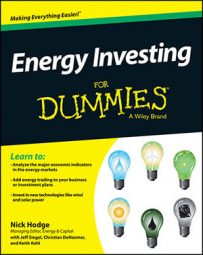As an energy investor, you have more than one way to achieve an investment goal. If you’ve ever heard people say, “Buy the Dow,” they’re referring to a fund that tracks the performance of the Dow Jones Industrial Average index.
Funds now exist that track almost any aspect of the market you can imagine. You can buy an oil service company fund, a wind energy fund, a coal fund, and so on.
Buying specific funds is one of the easiest ways to get exposure to the market. It’s also a way to make sophisticated investments on your own. You can buy a short fund, for example, or a leveraged fund. You can buy a fund that tracks the daily return of crude oil or one that returns twice the daily return of crude oil.
An exchange-traded fund (ETF) is a security that tracks the return of an index, commodity, or basket of stocks and that trades like a stock on an exchange. These funds are bought and sold throughout the day, and the price fluctuates as a result. Because of this, an ETF doesn’t have its net asset value calculated every day like a mutual fund.
Rather than track the return of an asset, a mutual fund pools together funds from many investors, and a professional money manager then invests those funds in stocks, bonds, money markets, or other investment vehicles. Because they’re professionally managed and diversified, mutual funds give small investors access to strategies that would be difficult to deploy with little amounts of capital.
Instead of buying shares at the current market price like with ETFs, mutual funds are bought and sold at their net asset value (NAV) per unit, which is calculated once per day based on the closing market prices of the securities in the fund’s portfolio.
The per-unit price of the fund is calculated by dividing the total value of the securities it holds, minus any liabilities, by the number of outstanding fund units. Each unit holder profits proportionally to the gain or loss of the fund’s NAV based on the number of units owned.
You should use ETFs if you know what sectors or indexes you want to invest in and have the confidence to buy and sell them on your own. Use mutual funds if you want to select general investment themes but want to leave the buying, selling, and diversification to a professional. Just know that you pay for this management with fees that eat into your returns.

